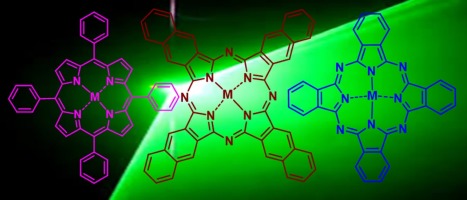Journal of Photochemistry and Photobiology C: Photochemistry Reviews ( IF 12.8 ) Pub Date : 2018-02-08 , DOI: 10.1016/j.jphotochemrev.2018.02.001 Mário J.F. Calvete , Danilo Dini

|
The control of the transmission of the energy transported by optical waves is of extreme importance for the realization of those advanced technologies which require high speed of operation and fast switching. Such a task can be approached through the design and preparation of materials that possess modulable optical properties. In the present review the aspect of material science behind the realization of the effect of optical limiting, OL (or optical power limiting, OPL), will be considered focusing on those materials based on conjugated metallo-macrocycles like porphyrins, phthalocyanines and derivatives. The choice of these molecular materials for OL purposes is motivated by the fact that the optical properties of such annulated systems can be finely modulated in a controlled fashion by changing the chemical structure of the complex. These changes involve the variation of the central metal, the extent of electronic conjugation of the ring, the nature and the number of peripheral ligands, and the eventual introduction of axial ligands coordinated by a central metals with a valence higher than +2. An attempt will be made to establish relationships between the structure of the macrocyclic complex and the relative OL properties taking into account the most recent developments in the field. During this analysis we will also discuss the aspect of optically passivity, i.e. the characteristic of the OL materials of undergoing fast changes of optical properties according to an internal mechanism of self-activation.
中文翻译:

具有光活化光吸收的共轭大环材料,用于控制脉冲辐射传递的能量传输
对于实现那些需要高速操作和快速切换的先进技术的实现,控制由光波传输的能量的传输极为重要。可以通过设计和制备具有可调节光学特性的材料来实现这一任务。在本综述中,将考虑实现光限制OL(或光功率限制OPL)效应背后的材料科学方面,重点关注基于共轭金属大环化合物(如卟啉,酞菁和衍生物)的那些材料。这些分子材料用于OL的选择是受以下事实的启发:可以通过控制配合物的化学结构,以受控方式精细控制此类环状体系的光学性能。这些变化涉及中心金属的变化,环的电子共轭程度,外围配体的性质和数量,以及最终引入由价态高于+2的中心金属配位的轴向配体。考虑到该领域的最新发展,将尝试建立大环复合物的结构与相对的OL性质之间的关系。在此分析过程中,我们还将讨论光学无源性的方面,即,根据自激活的内部机制,光学性能快速变化的OL材料的特性。最终引入由价态高于+2的中心金属配位的轴向配体。考虑到该领域的最新发展,将尝试建立大环复合物的结构与相对的OL性质之间的关系。在此分析中,我们还将讨论光学无源性的方面,即,根据自激活的内部机制,光学性能快速变化的OL材料的特性。最终引入由价态高于+2的中心金属配位的轴向配体。考虑到该领域的最新发展,将尝试建立大环复合物的结构与相对的OL性质之间的关系。在此分析中,我们还将讨论光学无源性的方面,即,根据自激活的内部机制,光学性能快速变化的OL材料的特性。











































 京公网安备 11010802027423号
京公网安备 11010802027423号